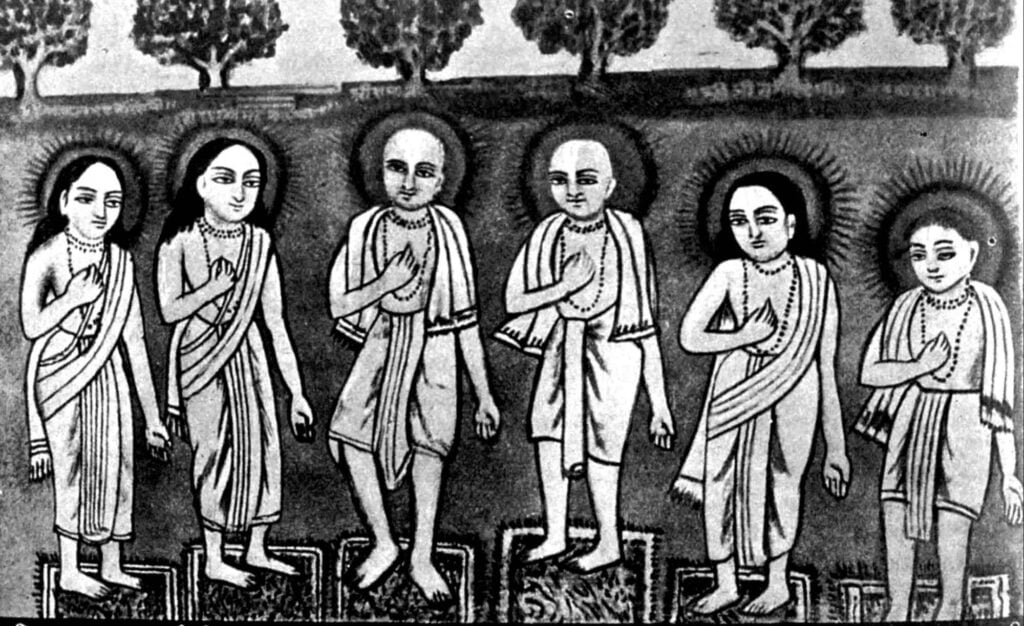Overview
The Introduction to Śrī Kṛṣṇa Vijaya was written by Bhaktivinoda Ṭḥākura in 1887. The poem Śrī Kṛṣṇa Vijaya by Guṇarāja Khāṅ ( Śrī Mālādhāra Vasu) was practically lost until Bhaktivinoda republished it again. In this introduction, the Ṭhākura explains the significance of this work and gives an biography of Guṇarāja Khāṅ.
(translated by Swami B.V. Giri)
This poem is a treasure of special affection and honour for the people of Bengal. We have collected it with great difficulty and published it. I hope everyone will read it with affection.
As far as we know, we have concluded that this book is the ādi-kavya (original poem) of the Bengali language. Ādi-kavi Guṇarāja Khaṅ Mahāśaya was engaged in compiling this book in 1395 Śakābda (1472 CE), and completed it in 1402 Śakābda (1479 CE). Before this, Caṇḍī Dāsa and Vidyāpati Ṭhākura had written something in Bengali, but they did not compose any poetry. We only see a few independent songs, but we have not seen any poetry in the Bengali language written before the Fourteenth Century of the Śaka Era.
The composition of the book Śrī Kṛṣṇa Vijaya is very simple, so that the half-educated women and semi-literate men of the lowers classes of Bengal can read and understand this book effortlessly. The language of this book is not ornamental. In many places, the verses are not so sweet. In many places with the fourteen syllable payār metre, there can be seen sixteen or seventeen syllables, and twelve or thirteen syllable. Many of the words are those that were in vogue at that time. All these words cannot be understood except for a person from Rāḍha-deśa. No matter how many faults there are in it, we respect it in the same way that the people of Britain regard Chaucer. No Bengali library can be said to be complete without this book.
Moreover, this book is extremely dear to spiritual persons. The best of all Vaiṣṇavas, Śrī Guṇarāja Khāṅ Mahāśaya, has compiled this book as a translation of the Tenth and Eleventh Cantos of Śrī Śrīmad Bhāgavata, the crest jewel amongst all the śāstra. Therefore, we cannot describe the glories of this book here in this small introduction. This book is completely worshipable by the Vaiṣṇava world. In the 15th Chapter of the Madhya-khaṇḍa of Śrī Śrī Caitanya-caritāmṛta, Śrī Śrī Mahāprabhu spoke as follows in Kulīna-grama concerning the Vasu Vaiṣṇavas:
kulīna-grāmīre kahe sammāna kariyā
pratyabda āsibe yātrāya paṭṭa-ḍorī lañā
guṇarāja-khāṅna kaila śrī-kṛṣṇa-vijaya
tāhāṅ eka-vākya tāṅra āche premamaya
nandanandana kṛṣṇa mora prāṇa-nātha
ei vākye vikāinu tāṅra vaṁśera hāta
tomāra ki kathā, tomāra grāmera kukkura
sei mora priya, anya-jana rahu dūra
(With respect, the Lord asked the residents of Kulīna-grāma to come every year for the Ratha Yātrā and bring silk rope. The Lord said, “Guṇarāja Khāṅ compiled Śrī Kṛṣṇa-vijaya, in which one of his statements describes his prema – ‘Kṛṣṇa, the son of Nanda, is the Lord of my very life.’ By this statement I have sold Myself to his descendants. What to say of you, even a dog in your village is dear to Me, what to speak of others?” – Caitanya-caritāmṛta, Madhya-līlā 15.98-101)
The authenticity, reverence and excellence of this book is proven by the above verses. Needless to say, after reading a book that Śrī Śrī Mahāprabhu Himself has praised, it has gained respect in Gauḍīya Vaiṣṇava society.
No doubt the esteemed reader will now enthusiastically ask about the identity of Śrī Guṇarāja Khāṅ Mahāśaya. I will write whatever I am aware of. Unable to find any brāhmaṇas or kāyasthas possessing any proper conduct in Bengal, which was contaminated by Buddhism, the ruler of Bengal, Ādiśūra, brought five good brāhmaṇas and five good kāyasthas from Kānyakubja. Among those five kāyasthas, the civilised and simple-hearted Daśaratha Vasu Mahāśaya came to Gauḍa-deśa. and Śrī Guṇarāja Khāṅ appeared in that dynasty as his thirteenth descendent. Guṇarāja Khāṅ’s real name was Śrī Mālādhara Vasu, and the ruler of Gauḍa gave him the title ‘Guṇarāja Khāṅ.’ The succession is thus:
Daśaratha Vasu
|
Kuśala vasu
|
Śubha-Śaṅkara Vasu
|
Haṁsa Vasu
|
Śakti-Rāma Vasu (Bhāgāṇḍā), Mukti-Rāma Vasu (Māinagara), Alankāra Vasu (Baṅgaja)
|
Dāmodara Vasu (Son of Mukti-Rāma Vasu)
|
Antara-Rāma Vasu
|
Guṇī-Nāyaka Vasu, Vīnā-Nāyaka Vasu
|
Mādhava Vasu
|
Lakṣmīnātha Vasu, Cakrapāṇi Vasu, Udaya-Cāṅda Vasu, Loha Vasu, Toha Vasu
[Śrīpati Vasu, Acyutānanda Vasu]
|
Yajñeśvara Vasu, Trilocana Vasu, Vaṭeśvara Vasu, Prajāpati Vasu (Sons of Śrīpati Vasu)
|
[Īśāna Vasu, Sagara Vasu, Kṛpā-Rāma Vasu]
Bhagiratha Vasu, Kameśvara Vasu, Sadānanda Vasu, Vaśiṣṭha Vasu (Sons of Yajñeśvara Vasu)
|
Mālādhara Vasu (known as Guṇarāja Khāṅ)
He had fourteen sons, amongst whom the second son, Lakṣmīnātha Vasu, had the title ‘Satyarāja Khāṅ.’ His son, Śrī Rāmānanda Vasu was an associate of Śrī Śrīman Mahāprabhu. Rāmānanda Vasu was the fifteenth descendant.
After extensive research in Kulīna-grāma, we collected this genealogy from the house of the respected Vasus during the winter of 1292 (1885 CE). We discovered there that Śrī Mālādhara Vasu Mahāśaya was a very renowned and wealthy personality. From seeing his fort, temple etc., it seems that his province was extremely prosperous. I have also found evidence of Guṇarāja Khāṅ Mahāśaya’s social courage. Knowing that the practice of King Ballal Sena’s distribution of nobility was useless, the virtuous Dattas of Bali Samāja, from the dynasty of our ancestor Śrī Puruṣottama Datta, never acknowledged it.* But their fellow residents from the Ghoṣa, Vasu and Mitra dynasties accepted that practice as beneficial for them. Due to his sharp intellect, Mahātmā Mālādhara Vasu was aware of the unfortunate consequences of such a practice and, rejecting the request of his cousin Purandara Khāṅ, he performed the wedding of his eldest son along with the daughter of Śrīpati Datta Mahāśaya who was in the thirteenth generation of the dynasty of Śrī Puruṣottama. In this way, he established the superiority of marital affairs amongst the kāyasthas of Kānyakubja within their own class, compared to the tradition stemming from Ballal and Purandara. Those that review the present state of Kāyastha society have established it as the work of Śrī Mālādhara Vasu in view of the present unfortunate consequences that are due to the customs of Ballal and Purandara.
*Translators Note: King Ballal Sena gave the noble status (kulina) to the Ghoṣa, Vasu and Mitra families, but due to envy of the Datta dynasty, he denied them any high social position and claimed they were śūdras. For more information one should read Datta Vaṁśa Mālā.
The manuscript we have used to print this book shows that it was written by Śrī Devānanda Vasu in 1405 Śakābda (1484 CE), two years before the advent of Śrī Śrī Mahāprabhu. By the grace of the descendant of Śrīmad Uddhāraṇa Datta Ṭhākura Mahāśāya, Śrīyuta Hārādhana Datta Mahāśaya, a resident of Kayāpāṭa Badangañj near Jāhānābād, we received this old handwritten manuscript. The famous Aula Manohāra Dāsa Bābājī gave the book to Kṛpā-Rāma Singh Mahāśaya. He was the great maternal grandfather of the above mentioned Datta Mahāśaya. The manuscript was written on soft cotton paper which was very old and in tatters, and only certain pieces could be salvaged. The people of Bengal are indebted to Śrīyukta Hārādhana Datta Mahāśaya for publishing this book.
Footnote:
The Ṭhākura’s achievement was mentioned in the ‘Notices of Sanskrit Manuscripts’ published by the British government of Bengal in 1887:
“Śrīkṛṣṇavijay by Gunarāj Khān, acquired at Viṣṇupur, in Bankura. Babu Kedār Nāth Datta, a retired Deputy Collector, who has published an edition of this work, edited it from a worm-eaten bad manuscript. Our codex is complete, and in very good preservation.”













